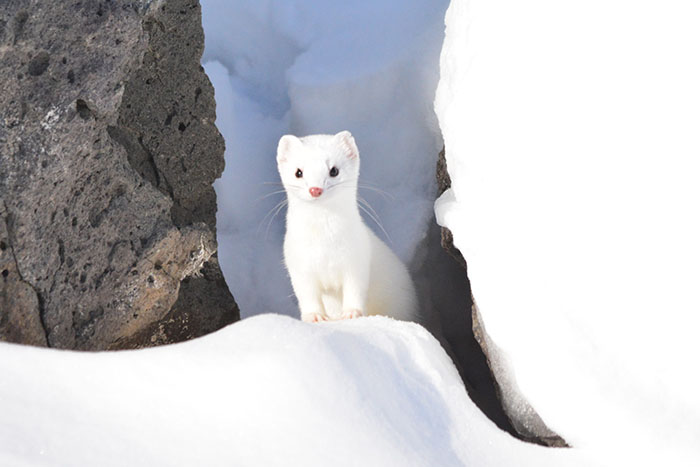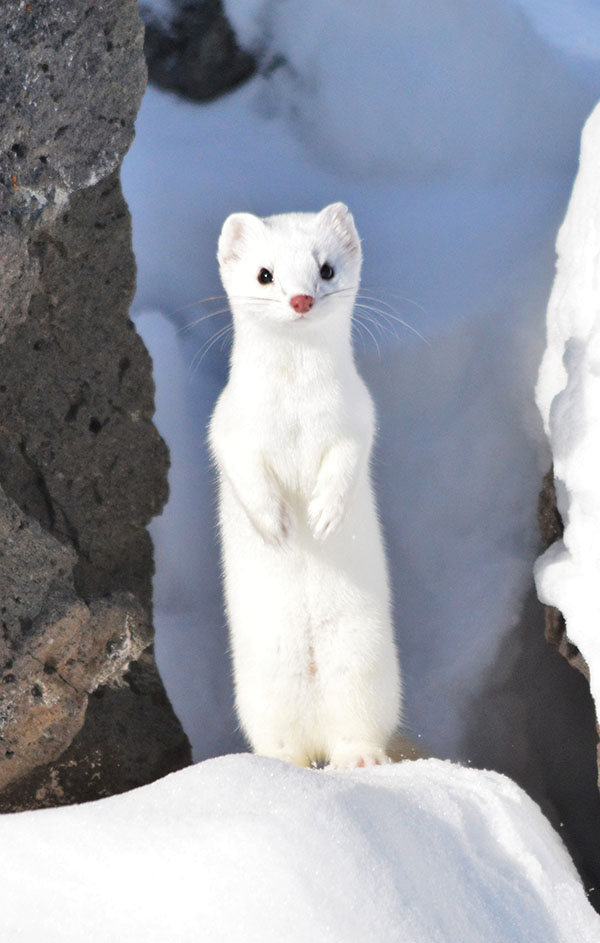Secret life of the Long-tailed weasel
Published at | Updated at
Two small black dots were staring at me from a hole in the snow. Then I saw the pink nose below the dots: a Long-tailed weasel was glaring at me between two snow-covered rocks. For an hour I watched the weasel dart from hole to hole hunting for some food – but none was captured, so it headed across the freshly fallen snow looking for a more productive area.
Twice each year weasels change their coats. In the fall they molt from a golden tan to pure white except for the black tip of their tail. In the spring they shed that beautiful white coat for the tan one. During these molting times are the best opportunities to observe them as they do not blend into their surroundings all the time.
Back in civilized country, I posted a picture of the weasel on Facebook and was soon corrected, several times, that I had a picture of an ermine. So off to the “plague of modern society” I went (the computer) searching for the answer. It was a Long-tailed weasel after all.
In Idaho, we have three weasels that turn white in the winter. The Least weasel is a very small one, almost mouse size; the Short-tailed weasel or ermine; and the Long-tailed weasel. The Short-tailed or ermine has about the same size body as the Long-tailed, but the ermine’s tail is only about 35% of its body length, while the Long-tailed is over 44% of it body length. Long-tailed are the most numerous in Idaho, yet there is still plenty of confusion about these creatures.
Where some of the confusion comes from is the fur from weasels that decorates European royalty and Catholic robes are called ermine even though most come from Long-tailed weasels.
They also developed a bad reputation for being blood-thirsty devils because of their behavior of attacking victims much larger than themselves. Their slaughter of chickens caused some states to place bounties on them in efforts to control them.
They have to be always on the hunt, though. Because of their long slender body and high metabolism, their bodies lose heat quickly, requiring them to eat about 75% of their body weight every day. Hunting and eating are full time jobs for them. When given the chance they will kill prey and store it. As many as 50 rodents have been found stored by weasels in hollow logs and burrows.
Their reproductive habits are also very strange. Breeding occurs in the summer when food is plentiful for them and their physical condition is best. The embryos do not implant on the female’s uterine wall until the next spring. About 25 days after this delayed implantation about six to eight young are born. Because of this delayed implantation, both the breeding and birth happens during peek abundant food supplies.
Most weasels have very short lives as only 15 to 25 per cent of them survive more than a year. Predation comes from owls, hawks, dogs, man and coyotes. Being such an aggressive creature, stories abound about them attacking their attackers. Buzzards, hawks and falcons have all been observed with weasels attached to them; the predator became the prey. Their ferocious attitude is not their only defense.
Being from the mustelidae family, they contain two stink bombs near their vent with a pungent smell worse than that of a skunk. This scent often colors the white tail a pale yellow color.
For an animal that once had bounties placed on them, the weasel has adapted well and their population is doing well. They may be close to you and you will never see them unless you see a couple of black beady eyes or a black tip of a tail in fresh fallen snow.

Living the Wildlife is brought to you by Yellowstone Teton Territory. Experience 7,500 square miles of untamed wilderness in Eastern Idaho's Yellowstone Teton Territory. Where majestic peaks meet endless adventure, your perfect outdoor escape is waiting. Start planning at YellowstoneTeton.com.
EastIdahoNews.com comment boards are a place for open, honest, and civil communication between readers regarding the news of the day and issues facing our communities. We encourage commenters to stay on topic, use positive and constructive language, and be empathetic to the feelings of other commenters. THINK BEFORE YOU POST. Click here for more details on our commenting rules.







